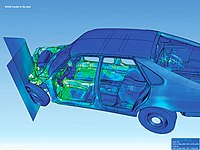
Photo from wikipedia
Purpose During severe earthquakes, the inelastic energy dissipation of eccentrically braced frame system depends on shear links performance. A finite element model can predict links behavior appropriately if the factors… Click to show full abstract
Purpose During severe earthquakes, the inelastic energy dissipation of eccentrically braced frame system depends on shear links performance. A finite element model can predict links behavior appropriately if the factors causing large discrepancies are recognized and modified. The paper aims to discuss this issue. Design/methodology/approach In order to achieve this, the present paper discusses the cyclic response of five types of shear links constructed of various steel grades that ranged from 100 to 485 MPa yield strength. Finite element models are verified by experimental results. As these links have substantial differences in strain hardening of steel materials, different amplitudes of material stress‒strain curve loops are used to specify the level of strain hardening in finite element models. Findings The solid and shell elements in ABAQUS element factory can predict local buckling perfectly, and the computation cost of the former is significantly more than the latter. However, one of the solid elements can predict plastic deformation accurately if no local buckling emerges. The axial constraint of test setup equipment can cause excessive plastic deformation in comparison to the link plastic rotation capacity. Furthermore, some shear links with middle stiffeners can reach inaccurate high plastic rotations due to lack of defining fracture criteria in finite element models. Originality/value In this study, some resources of discrepancies between experimental results and finite element models are mentioned to ensure the reliable use of finite element models.
Journal Title: International Journal of Structural Integrity
Year Published: 2019
Link to full text (if available)
Share on Social Media: Sign Up to like & get
recommendations!